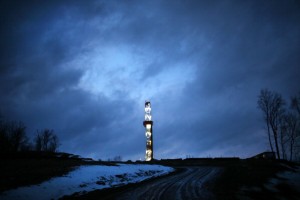How Much Methane is Leaking From Gas Drilling? New Study Aims to Answer

Photo by Spencer Platt/Getty Images
A Cabot Oil and Gas natural gas drill is viewed at a hydraulic fracturing site on January 17, 2012 in Springville, Pennsylvania. A domestic drilling boom has led to concern that more methane is leaking into the atmosphere.
A new study of natural gas drilling sites out today offers mixed results on methane leakage during the drilling and production process, one issue in an ongoing debate over the safety and risks involved with a new surge in domestic drilling.
Since domestic drilling for oil and natural gas has taken off with the help of techniques like fracking and horizontal drilling, a constant question has been how much methane (aka natural gas) is leaking into the atmosphere during the process. Methane is a potent greenhouse gas, says Drew Nelson with the Environmental Defense Fund, who helped coordinate the study. “For every molecule of methane that is emitted into the atmosphere, that molecule has the potential to undermine and erode the benefits of natural gas compared to other fossil fuels,” Nelson says.
Increased supplies of natural gas mean less coal (which has nearly twice the greenhouse impact of gas) is being burned in the country. But if too much methane is leaking, those climate gains could be lost.
The study, authored by David Allen of the University of Texas at Austin, is unique in its methodology. While previous studies have relied on estimates or downwind measurements, Allen’s team is the first to monitor emissions at nearly 200 drilling sites across the country directly for a year and a half. Previous studies of methane leakage had found varying rates, some as high as 8 percent. But Allen says direct access to the drilling sites themselves provided researchers with more accurate measurements.
“Participation of the companies was critical, because they provided us with access to production sites and equipment,” Allen said during a conference call with reporters ahead of the study’s release. Companies volunteered to participate, and weren’t randomly selected, and several drilling companies funded the study with the Environmental Defense Fund. A study on fracking and water contamination last year, also conducted by the University of Texas, came under fire after revelations of improper financial ties by its lead author and improper review and methodology. Today’s university release on the study discloses industry ties and funding, as well as the steps taken to review the results.
(Update: You can read some critiques of the study and it’s industry backing and involvement, here from the group Physicians Scientists & Engineers for Healthy Energy.)
While working closely with the industry for the study is likely to raise eyebrows in parts of the environmental community, the authors maintain that getting this specific data would not have been possible without collaborating with the industry.
Allen said that the data was collected and held by the study team the entire time, and the study was reviewed both by an independent scientific advisory panel and anonymous scientific peer review. The study is being published in the Proceedings of the National Academy of Sciences.
Emissions from drilling have dropped steadily in recent years, according to EPA estimates, but still make up 2.3 million metric tons of methane sent into the atmosphere. This study suggests the decline in emissions from drilling could continue if the industry takes steps to combust or capture more of the leaking methane. In the new study, wells using “green completions” that capture or control methane leaked only 1 percent during the drilling and preparation of the well for production. “It’s very effective,” Allen says.
Wells without those safeguards allowed widely varying amounts of methanes to escape.
Under federal regulations the EPA passed last year, natural gas drilling companies will have to control emissions tightly during well completions on all new wells by January 2015, and cannot vent methane during drilling. “Those regulations work, and have been very successful in driving down emissions from the completion process,” Nelson of EDF says. Soon, all completions will be “green.”
But there are areas where drillers could improve, particularly after the drilling process is complete and the well moves into normal production, the study says. “Emissions from some of the day-to-day activities, including valves, are actually higher, this study found, than EPA estimates,” Nelson says, “suggesting that there are plenty of opportunities for reduced emissions coming from gas production.”
Previously well completions were thought to be responsible for much of the emissions; this new study shows that equipment and valves are responsible for more, and deserve scrutiny. That equipment can account for about 40 percent of methane emissions from natural gas drilling and production.
Other parts of the drilling and production process were not included in the study, like storage tanks, which have been known to leak. While the team did try to measure some tanks, they discovered that one of the main parts of the tank that leaked was too high off the ground, making it difficult to access and measure potential leakage. “We feel as though we were getting measurements that weren’t capturing all of the emissions from the tanks,” Allen says.
“There are still lots of leaks that take place,” Nelson notes. “Those leaks are lower than some of the other studies, but that doesn’t mean that they’re low enough to ensure that natural gas is better than other fossil fuels at all points in time.” More data is needed, Nelson says, and this study is only one of 16 that the Environmental Defense Fund is coordinating on methane leakage, in the hopes that finding and targeting the leaks will lead to fixing them.
Not examined in the study were any oil wells, which are also not subject to the new EPA regulations for “green completions.” “We collectively need a better sense of where the emissions are from those,” Nelson of EDF says. If oil wells were subject to the same emissions standards as natural gas wells are going to be, there would be a “pretty dramatic fall” in methane emissions from drilling, Nelson says. But it’s a matter of debate if the EPA’s Clean Air Act authority that allowed it to pass rules for natural gas drilling would also apply to oil drilling.

